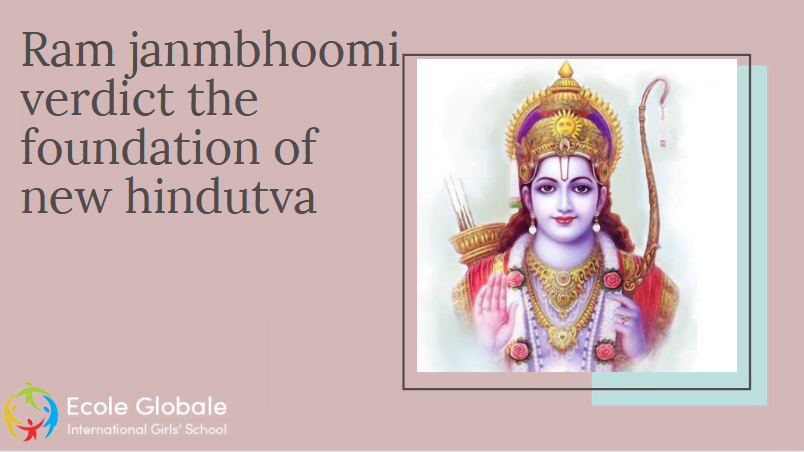The Ayodhya Ram janmabhoomi temple- the birthplace of the Hindu God- Ram (Ayodhya, Uttar Pradesh) will be remade- recently ordered by the supreme court. So why is it such a big issue? To begin with, talk about the most ideal approach to manage a realm, paying little mind to the religion, rank or etymological foundation of the Indian being asked, for all intents and purposes all would state, Ram Rajya.
There can be different speculations on why the term Ram Rajya is so instinctively discussed among the general Hindu population despite being little information about the so-called ‘ Ram Rajya‘ in the Ramayana (the holy Indian epic). The epic mostly talks about Ram’s struggles as a child and the romantic tale of him with Lady Sita and the battle with Raavana (his archenemy). The Indians who (probably) lived in Lord Ram’s time encountered their own idea of Ram Rajya. Also, our ancestors chose that their relatives must make up their own personalities on what Ram Rajya ought to be. Along these lines, our convention directs that we should all think, consider and discuss, on what Ram Rajya can mean in the present occasions. Seen from this point of view, the different renditions of Ramayana are a motivation for what we can be- How a leader ought to or ought not to be; how people ought to or ought not to be. according to ram mandir supreme court, it is accepted that its a place of ram.
However, a dialogue on Ayodhya ram Janam can possibly happen when we are clear about what our identity is (as a human where our ideologies stand). What’s more, this choice is generally taken by the decision top classes (aka Macaulayputras) in the social order; the class that involves the top legislators, civil servants, legal executive, scholarly community, media, corporates, specialists, and so on. Macaulayputras- the offspring of Macaulay, the offspring and love children of the mastermind behind the British approaches to make a class that was Indian in blood, yet British in nature, language and culture. The lifestyles this class practice, the social images they pursue, the language they talk, are all, to a great extent, a legacy of the British Raj. That doesn’t imply that they don’t cherish India. Obviously, they do. It just implies that their strategy for communicating that adoration is unique; they consider themselves to be reformers of land that is a pre-present day (some among them utilize the expression “savage”). When you see people from this class, you additionally see how this class approaches everything Indian. Furthermore, among the ancient Hindu Gods, the one that this class scorned the most was Lord Ram.
Furthermore, another clan is in the rising today, to take over as the decision-making class. For the need of a superior term, we should consider them the Dhartiputras; the children of the dirt. Since the Dhartiputras are plainly the future generations, the discussion inside this class is generally significant in India today. Like the Macaulayputras, this class also cherishes India. Yet, at the core, all things considered, the speech this class utilizes, the food they eat, the social images they pursue, are generally based on old Indian conventions.
What’s more, it is nothing unexpected that this class worships Lord Ram. So this class addresses Lord Ram when they think they have to, for instance on his treatment of Goddess Sita. However, that doesn’t detract from the profound and tolerating regard they have for Lord Ram.
Presently, the Dhartiputras have not yet assumed control over the top social order. Even ideologically, they are a work in progress class to be precise. Some among them, even today, feel an instinctive aversion for the Macaulayputras and consider them to be “the adversary”. They squander a lot of vitality battling them. This is silly. They ought to gain from the manner in which Lord Ram treated others, even the individuals who were “His adversaries”.
What should this class accomplish for its kin, for example, us, basic Indians? What sort of society do we need? What is the Indian dream of an ideal Ram Rajya? What is our way to deal with science? What is our way to deal with Women’s privileges? What is our way to deal with different sexual orientations and minorities? Do we trust in various laws dependent on group rights (as the Macaulayputras did) or do we have confidence in One law for all,? What is the harmony between financial development and environmentalism? What is the harmony among pacifism and opposing nations who don’t wish us well? What is the harmony between request and opportunity? Do we trust in the idea of the blame for recorded wrongdoings? Do we have confidence in the idea of network blame? What is our way to deal with education? To history? To expressions of the human experience? To writing?
There is such a great amount to be examined, analyzed and discussed. So, there is a lot to be discussed. Furthermore, it should all occur in the general societal structure. We should place those considerations without hesitation; the Dhartiputras, perhaps, alongside the Macaulayputras, would all be able to work to benefit the everyday citizens. For this is the thing that Lord Ram would anticipate that we should do, the best method to respect Him. Although many Indians were influenced by this case, however, most colleges, corporates, and boarding schools in India were not at all affected by the Ayodhya Ram janmabhoomi case. As they believe whatever supreme court will announce the judgment they will accept it.









